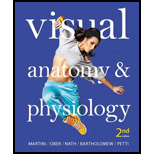
Visual Anatomy & Physiology (2nd Edition)
2nd Edition
ISBN: 9780321918949
Author: Frederic H. Martini, William C. Ober, Judi L. Nath, Edwin F. Bartholomew, Kevin F. Petti
Publisher: PEARSON
expand_more
expand_more
format_list_bulleted
Concept explainers
Question
Chapter 17, Problem 2CRQ
Summary Introduction
Introduction: White blood cells (WBCs) are immune cells that play a major role in the body’s defense mechanism. WBCs, also known as leukocytes, protect the body from foreign antigens and infectious diseases. The five types of white blood cells are neutrophils, basophils, eosinophils, lymphocytes, and monocytes.
Expert Solution & Answer
Want to see the full answer?
Check out a sample textbook solution
Students have asked these similar questions
glg 112 mid unit assignment Identifying melting processes
Give only the mode of inheritance consistent with all three pedigrees and only two reasons that support this, nothing more, (it shouldn't take too long)
O
Chapter 17 Solutions
Visual Anatomy & Physiology (2nd Edition)
Ch. 17.1 - Prob. 1.1RCh. 17.1 - Prob. 1.2RCh. 17.1 - Prob. 1.3RCh. 17.1 - Prob. 2.1RCh. 17.1 - Prob. 2.2RCh. 17.1 - Prob. 2.3RCh. 17.1 - Prob. 3.1RCh. 17.1 - Prob. 3.2RCh. 17.1 - Prob. 3.3RCh. 17.1 - Prob. 1LO
Ch. 17.1 - Describe the important components and major...Ch. 17.1 - Prob. 3LOCh. 17.1 - Prob. 1SRCh. 17.1 - Prob. 2SRCh. 17.1 - Prob. 3SRCh. 17.1 - Prob. 4SRCh. 17.1 - Prob. 5SRCh. 17.1 - Prob. 6SRCh. 17.1 - Prob. 7SRCh. 17.1 - Prob. 8SRCh. 17.1 - Prob. 9SRCh. 17.1 - Prob. 10SRCh. 17.1 - Prob. 11SRCh. 17.1 - Prob. 12SRCh. 17.1 - Prob. 13SRCh. 17.1 - Prob. 14SRCh. 17.1 - Prob. 15SRCh. 17.2 - Prob. 1.1RCh. 17.2 - Prob. 1.2RCh. 17.2 - Prob. 1.3RCh. 17.2 - Prob. 2.1RCh. 17.2 - Prob. 2.2RCh. 17.2 - Prob. 2.3RCh. 17.2 - Prob. 3.1RCh. 17.2 - Prob. 3.2RCh. 17.2 - Prob. 3.3RCh. 17.2 - Prob. 4.1RCh. 17.2 - Prob. 4.2RCh. 17.2 - Prob. 4.3RCh. 17.2 - Prob. 5.1RCh. 17.2 - Prob. 5.2RCh. 17.2 - Prob. 5.3RCh. 17.2 - Prob. 6.1RCh. 17.2 - Prob. 6.2RCh. 17.2 - Prob. 6.3RCh. 17.2 - Prob. 7.1RCh. 17.2 - Prob. 7.2RCh. 17.2 - Prob. 7.3RCh. 17.2 - Prob. 8.1RCh. 17.2 - Prob. 8.2RCh. 17.2 - Prob. 8.3RCh. 17.2 - Prob. 1LOCh. 17.2 - Prob. 2LOCh. 17.2 - Prob. 3LOCh. 17.2 - Prob. 4LOCh. 17.2 - Prob. 5LOCh. 17.2 - Prob. 6LOCh. 17.2 - Prob. 7LOCh. 17.2 - Prob. 8LOCh. 17.2 - Prob. 1SRCh. 17.2 - Prob. 18SRCh. 17.2 - Prob. 19SRCh. 17.2 - Prob. 20SRCh. 17.2 - Prob. 21SRCh. 17.2 - Prob. 22SRCh. 17.2 - Prob. 23SRCh. 17.2 - Prob. 24SRCh. 17.2 - Prob. 25SRCh. 17.2 - Prob. 26SRCh. 17.2 - Prob. 27SRCh. 17.2 - Prob. 28SRCh. 17.2 - Prob. 29SRCh. 17.2 - Prob. 30SRCh. 17 - Prob. 1CRQCh. 17 - Prob. 2CRQCh. 17 - Prob. 3CRQCh. 17 - Prob. 4CRQCh. 17 - Prob. 5CRQCh. 17 - Prob. 6CRQCh. 17 - Prob. 7CRQCh. 17 - Prob. 8CRQCh. 17 - Prob. 9CRQCh. 17 - Prob. 10CRQCh. 17 - Prob. 11CRQCh. 17 - Prob. 12CRQCh. 17 - Prob. 13CRQCh. 17 - Prob. 14CRQCh. 17 - Prob. 15CRQCh. 17 - Prob. 16CRQCh. 17 - Prob. 17CRQCh. 17 - Prob. 18CRQCh. 17 - Describe the various types of leukemias.
Ch. 17 - Prob. 20CRQCh. 17 - Prob. 21CRQCh. 17 - Prob. 1CICh. 17 - Prob. 2CICh. 17 - Prob. 3CICh. 17 - Prob. 4CICh. 17 - Prob. 5CICh. 17 - Prob. 6CICh. 17 - Prob. 7CI
Knowledge Booster
Learn more about
Need a deep-dive on the concept behind this application? Look no further. Learn more about this topic, biology and related others by exploring similar questions and additional content below.Similar questions
- Describe the principle of homeostasis.arrow_forwardExplain how the hormones of the glands listed below travel around the body to target organs and tissues : Pituitary gland Hypothalamus Thyroid Parathyroid Adrenal Pineal Pancreas(islets of langerhans) Gonads (testes and ovaries) Placentaarrow_forwardWhat are the functions of the hormones produced in the glands listed below: Pituitary gland Hypothalamus Thyroid Parathyroid Adrenal Pineal Pancreas(islets of langerhans) Gonads (testes and ovaries) Placentaarrow_forward
- Describe the hormones produced in the glands listed below: Pituitary gland Hypothalamus Thyroid Parathyroid Adrenal Pineal Pancreas(islets of langerhans) Gonads (testes and ovaries) Placentaarrow_forwardPlease help me calculate drug dosage from the following information: Patient weight: 35 pounds, so 15.9 kilograms (got this by dividing 35 pounds by 2.2 kilograms) Drug dose: 0.05mg/kg Drug concentration: 2mg/mLarrow_forwardA 25-year-old woman presents to the emergency department with a 2-day history of fever, chills, severe headache, and confusion. She recently returned from a trip to sub-Saharan Africa, where she did not take malaria prophylaxis. On examination, she is febrile (39.8°C/103.6°F) and hypotensive. Laboratory studies reveal hemoglobin of 8.0 g/dL, platelet count of 50,000/μL, and evidence of hemoglobinuria. A peripheral blood smear shows ring forms and banana-shaped gametocytes. Which of the following Plasmodium species is most likely responsible for her severe symptoms? A. Plasmodium vivax B. Plasmodium ovale C. Plasmodium malariae D. Plasmodium falciparumarrow_forward
- please fill in missing parts , thank youarrow_forwardplease draw in the answers, thank youarrow_forwarda. On this first grid, assume that the DNA and RNA templates are read left to right. DNA DNA mRNA codon tRNA anticodon polypeptide _strand strand C с A T G A U G C A TRP b. Now do this AGAIN assuming that the DNA and RNA templates are read right to left. DNA DNA strand strand C mRNA codon tRNA anticodon polypeptide 0 A T G A U G с A TRParrow_forward
arrow_back_ios
SEE MORE QUESTIONS
arrow_forward_ios
Recommended textbooks for you
 Human Physiology: From Cells to Systems (MindTap ...BiologyISBN:9781285866932Author:Lauralee SherwoodPublisher:Cengage Learning
Human Physiology: From Cells to Systems (MindTap ...BiologyISBN:9781285866932Author:Lauralee SherwoodPublisher:Cengage Learning



Human Physiology: From Cells to Systems (MindTap ...
Biology
ISBN:9781285866932
Author:Lauralee Sherwood
Publisher:Cengage Learning


